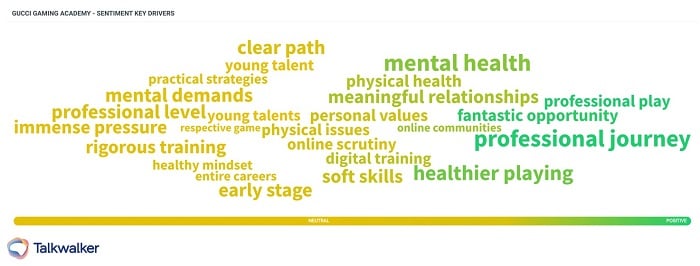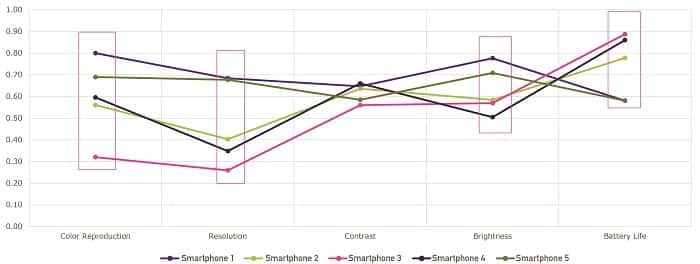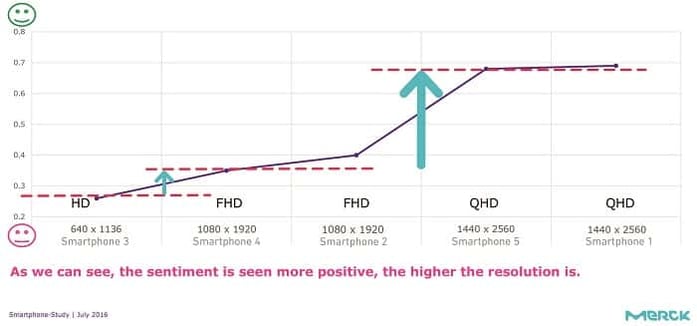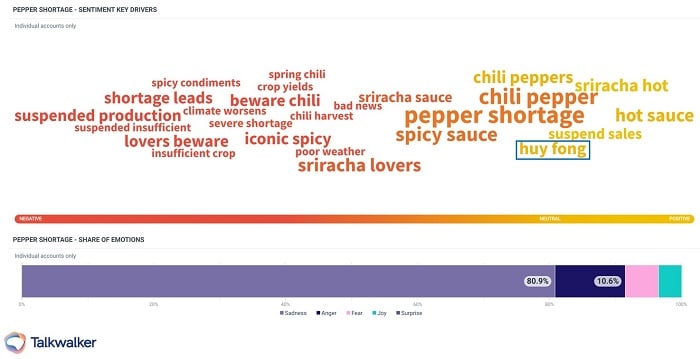I'd Like A Free Sentiment Analysis Demo!
Online sentiment analysis guide
This guide is going to walk you through sentiment analysis. Why you should be using it, what it is, and how to do it. There’ll be real-life brand examples and a demo of the best - and by that I mean, most accurate - tool on the market.
Why is sentiment analysis crucial to your brand? I’ll go into more detail later, but here’s a teaser:
- Monitor your brand health - understand how consumers feel about your brand. Address pain points, respond to feedback, give them what they want.
- Manage a potential crisis - spot an issue before it becomes a crisis. Watch for negative spikes and react quickly.
- Analyze your competitors - monitor conversations about the competition, and steer them towards your brand.
- Boost performance - track marketing campaigns, product launches, events.
Humans. We’re great at understanding the tone of a comment. We have contextual understanding and we can recognize praise, anger, indifference, sarcasm. We’re savvy to slang, and we can make sense of abbreviations.
Do I detect a hint of sarcasm?
Yes. But, would a machine analyzing this tweet see it as positive or negative? “Great job”, could be viewed as a positive sentiment.
Our cracking data science team have developed Talkwalker’s Blue Silk™ AI-enabled sentiment analysis tool that understands sarcasm and would recognize this as sarcastic and therefore, negative sentiment.
Table of contents
- Why is sentiment analysis important?
- What is sentiment analysis?
- 3 types of sentiment analysis
- How Merck KGaA uses sentiment analysis to enhance products based on consumer needs
- The best sentiment analysis tool
- Find out how consumers feel!
Why is sentiment analysis important?
What are your business goals? Increasing sales? Improving product development? Reducing customer churn? Driving loyalty? Sentiment analysis will help you achieve all these goals and more.
Manual sentiment analysis is possible if you don’t have much data, but when you take into consideration social media, reviews, forums, etc. There's too much data to manage. Sentiment analysis - opinion mining - tools will save you time and ensure your results are accurate.
Use opinion mining throughout the consumer journey to find any sticking points that are causing consumers to abandon their journey.
- Consumers love your product, but complain about slow delivery
- Your customer support team has an excellent rep, but your order process is buggy
A sentiment analysis strategy will drive loyalty and reduce customer churn, as the consumer journey is mapped and monitored. Fixing sticking points that’ll lead to an improved customer experience.
“Aaargh! My air fryer stopped working. I tweeted the brand for help, but didn’t receive a response, So I rang customer service. Spoke to a very nice person, who didn’t have a clue how to solve the problem.
They transferred me to another agent who tried to help, but failed. Transferred me to the technical team.
Yahoo! Problem solved, but I’m not 100% happy with being bounced around. Probably won’t buy from them again.”
This example shows that while the problem was resolved and the customer initially appears happy, “Yahoo!”, it’s clear that they’ll take their business elsewhere in the future.
Shared on social media, this would be a damning statement about the customer experience provided by this brand. Unlike a customer survey, which might only ask, “Did you receive your order?”, “Yes.”
A social listening strategy working hand in hand with sentiment analysis will find comments that customers post about your brand, and reveal the social media sentiment. Your brand will be able to then target and personalize responses.
Let’s look in more detail at the benefits of sentiment analysis…
Protect your brand reputation
If you understand the sentiment behind consumers’ comments, you’ll know how they feel towards your brand. Look for changes in sentiment - positive and negative - after launching a marketing campaign, attending an event, or launching a new product. Immediately address negative comments to avoid reputational damage.
Improve the customer experience
Tracking sentiment will give your CX team a heads up. It'll understand how a consumer feels at every stage of their journey. Any pain points encountered, can be solved quickly. The customer experience can be personalized, boosting engagement, driving more revenue, and reducing churn.
Talkwalker's consumer intelligence platform gathers sentiment analysis insights to help you create a streamlined customer experience.
Reduce customer churn
Use text analytics inbuilt sentiment analysis to evaluate consumer feedback based on positive, negative, and neutral words used. This’ll help you understand the reasons customers are churning, and use the data to build a model to identify churn triggers.
Track customer satisfaction
Sentiment analysis will help you put a quantifiable score on customer satisfaction - CSAT. You’ll identify the overall levels of customer satisfaction - they’re mood, perception of your brand, products, and services.
Manage a crisis
Use sentiment analysis and monitor consumer comments in real time. A sudden increase in negative mentions, tackled immediately, can stop an issue becoming a crisis. If you are hit by a PR disaster, measuring the sentiment and filtering the comments by severity of negativity, makes it easier to target your messages and avert a PR crisis.
Identifying conversation with positive sentiment means you can amplify those messages, and bonus… find positive user-generated content that can be incorporated in your marketing strategy.
Crisis management - monitoring the dips and spikes in net sentiment over time enables brands to monitor events that cause negativity, and avert a crisis.
Analyze product sentiment
Use sentiment analysis to collect data from review sites and social media channels, to understand how customers feel about your products. Features, quality, packaging, price, etc.
- Find out what customers like and dislike about your product
- Get real-time insights when launching a new product
- Compare product reviews and comments with your competitors
In May 2022, Gucci partnered with esports platform FACEIT, to launch the Gucci Gaming Academy. It brought professional gamers in as brand ambassadors, with Swedish gamer Christopher Alesund tweeting the launch and going viral. This most engaged post collected nearly 5K interactions with sentiment predominantly positive.
The goal of the initiative was to cultivate skills and open up opportunities to esport talents, while providing support to people dealing with mental and physical issues derived from the pressure off in-game performane and online scutiny.
The brand can measure sentiment surrounding the launch and see that meaningful relationships, healthier playing, along with mental and physical health contribute to the 34% positive sentiment.
Gucci Gaming Academy’s focus on mental and physical health was among the sentiment key drivers for the 34% positive sentiment around the fashion giant’s new initiative.
Benchmark against competitors
Understand how your brand compares in your industry. Monitoring the sentiment surrounding your marketing campaigns and products and how it affects consumer perception of your brand, in comparison with your competitors, will enable you to create messaging that targets your target market and develop products that they’re demanding. And, if you see negative sentiment around a competitor’s campaign or product, you can steer conversation towards your brand/product and win new customers.
Use social media monitoring
A sentiment analysis strategy will allow you to monitor social media and find consumers’ opinions about your products, marketing campaigns, CEO, industry trends, competitors’ products, and more.
Analyze the feedback, respond to negative reviews, avert a PR crisis, and share feedback with your product development team and customer support, collect positive user-generated content and employ it in your marketing strategy.
Find brand influencers
Tracking sentiment will not only reveal how consumers feel, but it will help you find influencers that are discussing your brand in a positive way.
If you search for keywords in your industry, you can then find potential influencers that are discussing these topics. Find those that have positive sentiment surrounding their content, and the reaction of their fans and followers, and your industry.
Improve customer service
Monitoring sentiment is the best way for your customer support team to track consumer dissatisfaction and address issues before the negativity grows. If your business relies heavily on word-of-mouth marketing - review sites - it’s crucial that you’re in tune with how customers feel about your brand.
On these public channels, if you can turn around these negative comments, appease the consumer and make them happy, you’re demonstrating to other consumers how efficient your brand is. Chances are, you’ll turn that frown upside down and win positive user- generated content.
What is sentiment analysis?
Sentiment analysis - opinion mining, emotion AI - is the use of natural language processing (NLP) to analyze conversations to determine the emotional state in human speech or text - positive, negative, neutral.
Brands should use machine learning-based sentiment analysis tools to look at speech and text shared by consumers, to understand if they’re statements are positive or negative. The insights gleaned, enable brands to be more empathetic in their responses, leading to improved customer relationships and loyalty.
User-generated content
Sentiment analysis will reveal a consumer’s opinion with regard to your product, services, team, location, ads, industry, and competitors. It’s a form of social media analytics that can improve your bottom line. The sentiment score of user-generated content can steer product development, warn of an escalating crisis, and increase the accuracy of your competitor analysis.
For instance, you’ve launched a new product and you want to know how it’s being received. You could instigate a costly market research survey and spend man-hours making cold calls. Or, you could use opinion mining to understand how everyone feels.
Natural language processing - NLP
Earlier, I casually dropped ‘natural language processing’ into the mix. Also called text analysis, data mining, or computational linguistics, it’s used in social listening to identify and analyze opinions in text. It’s a computer system that processes human language in terms of meaning. It can understand that words can make up a phrase. Phrases can make a sentence. Sentences transmit messages. Following analysis, it marks content as positive, negative, or neutral.
The insights revealed, to be of any use, have to be accurate. But humans aren’t logical, we don’t all speak the same language, we use slang, abbreviations, and acronyms. We express our emotions, and we’re liberal with sarcasm. We change topic mid article. We alter our tone of voice, depending on which channel we’re using. Be it a short tweet, a 2000 word review, or caustic customer feedback. How does a machine grasp the subtle nuances that are so natural to us?
Talkwalker’s sentiment analysis feature understands the human language - 127+ languages, to be precise - with up to an average 90% accuracy. It gets the sentiment, it gets the sarcasm. You’ll be able to source user-generated content and identify the positive and negative sentiment so you understand consumers’ preferences, what they’re passionate about, what they’re unhappy about, so you can streamline the customer experience, improve product development, and make smart business decisions to drive ROI.
Human vs machine
Teaching a machine to be human. Wow! Sarcasm, slang, and irony can still catch humans out. A sarcastic comment. Whoosh, straight over our head. Great, another sarcastic remark I missed. How wonderful. I’ll take a raincheck.
But, on the whole, we get it. For a machine, it has to be translated into objective and quantifiable scores that take into consideration the many nuances that we use when we speak. For instance…
“This guide is totally sick, the author destroyed it. Whoever wrote it is a legend!”
Aw, I’m blushing.
But, an untrained machine would think this is a bad guide, because the author ruined it. In fact, the author doesn’t even exist. The sentiment score of this statement would be negative.
Machine learning enables opinion mining to get more and more accurate, as sentiment analysis algorithms learn and adapt to the commonalities in conversations and how the context of conversations can change outcomes.
Emotional overload
When we share our opinions on social - comments, reviews, complaints - we also share our emotional state. We’re passionate about a new movie, outraged at a lack of customer care, tickled pink that our flight lands on time.
As a brand, you should be analyzing consumer emotions to understand what matters to them. Consumers that you want to fall in love with your brand. Use sentiment analysis to monitor online conversations to identify consumers’ emotions. Are they positive, negative, or neutral?
Show Me A Sentiment Analysis Tool With 90% Accuracy!
3 types of sentiment analysis
Keyword scoring, calculation based on predefined categories, and humans. Three methods adopted by most providers.
Keyword scoring
This method gives words positive or negative scores. Good = positive. Bad = negative. You see the problem?
— troye sivan (@troyesivan) October 24, 2015
Hmmm…
The advantage of keyword scoring is that it’s quick, predictable, and doesn’t cost the earth. Rules can be applied but the results can be inaccurate when used too broadly, because keyword based sentiment analysis doesn’t get context, sarcasm, or slang. Plus, depending on the engineer designating the percentages of what are considered negative and positive words, the results can fluctuate.
Quick and dirty - accuracy levels are roughly between 50 and 80%. Not reliable enough to make smart business decisions.
Predefined categories
This method has users categorizing several results - the training set. Then, an algorithm is employed to decide on future analysis. The level of accuracy is higher than with keyword scoring, but it’s flawed. Man-hours are extensive and the quantity of results is reduced.
While this method is more efficient with regard to the accuracy of the results, you don’t get much for your money. And, to get a handful of results, costs time and money.
Humans
Technology goes out the window with this method. Humans coding sentiment. The accuracy level is sick.
Hey grandpa, that means it’s good.
Man-hours? Ouch! Trying to catch a comment with negative sentiment and stop it from becoming a crisis, is a race against time.
Cost? Epic fail!
While the results are great, interpreting humans is always going to bring the best conclusion, it’s still subjective. Take into account the ever-growing social media world, and there’s way too much content for a team of humans to analyze without the aid of an automation tool.
Blue Silk™ AI-powered sentiment analysis
Our data science team is so baad! It developed our Blue Silk™ AI-enabled sentiment analysis that prioritizes the mentions to focus on. Understanding the full meaning behind a sentence - the true meaning - with an average 90% accuracy, from 127+ languages. It gets sarcasm. It gets slang. In consumer comments on social media, blogs posts, reviews, news sites, and more.
Deep learning models are used to simulate the cognitive functions of the human brain, understanding language patterns and basic sarcasm and irony - the algorithm copies how our brains understand.
To achieve a near 90% accuracy rate, our data science gurus had to classify tens of millions of results. Result!
Hasta la vista, baby!
How Merck KGaA uses sentiment analysis to enhance products based on consumer needs
Merck KGaA is one of Germany’s leading science and technology companies. Looking to improve product development, it turned to Talkwalker’s sentiment analysis.
One of Merck’s key products are liquid crystals - those things that manage light in LCD screens. The brand’s dilemma? Should it focus on products that bring a higher resolution and brightness, or products that improve the contrast ratio? What would consumers prefer for their smartphones?
Comparison of features of high-end smartphones by sentiment.
Results proved that resolution and brightness - along with color and battery - were critical, while consumers didn’t consider contrast to be that important.
Sentiment analysis of resolution.
Digging deeper, it became apparent that the need for high resolution screens has positive sentiment. Armed with insights that answered the question - what do customers want? - Merck focused on enhancing resolution and brightness. Leaving contrast concerns to another day.
In this instance, acute sentiment analysis on a niche topic, brought precise results. Cross-referencing the sentiment data with specific product features, meant that Merck could adapt its product strategy accordingly.
READ THE MERCK KGAA CASE STUDY
The best sentiment analysis tool
Having checked out numerous sentiment analysis tools on the market, I’m not going to waste your time with a great long list. Knowing that your top priority is accuracy, there is only one tool worth mentioning.
Ahem… say hello to Talkwalker.
Sentiment analysis isn’t rated in the social listening industry. Why? Because of all the man-hours involved, which leads to huge expenditure. But our data science team has overcome that, in spectacular fashion.
Talkwalker’s Blue Silk™ AI-enabled sentiment analysis now gives brands the ability to identify consumer sentiment with up to an average 90% accuracy. It’s so sick, I’ll say it again… sentiment analysis with 90% accuracy.
Let's take a look at the recent chili pepper shortage, and how consumers reacted to not being able to buy their favorite Sriracha Hot Chili Sauce, Chili Garlic, and Sambal Oelek.
When Huy Fong, the brand behind one of the US’s most beloved condiments, first confirmed the shortage, the news received over 4.2K mentions. The brand explained that the crisis was due to high temperatures and drought in the US.
We took a look at consumer conversations and found that over half showed negative sentiment. Not good for any brand. But, if Huy Fong used sentiment analysis, it would have found that consumers were sharing their disappointment. Warning of a Sriracha sauce shortage. They weren't angry at the brand, but sad that they couldn't buy from their favorite brand.
Sentiment analysis revealed that consumers weren't being negative about the brand. An overwhelming 80.9% were sad.
Find out how consumers feel!
Exact science? No. But, our data science team absolutely will not stop, ever...
At Talkwalker, we understand that being able to accurately classify sentiment is essential. Brands need to be able to benchmark brand health indicators, supplement the data with demographic information, and combine product features to give consumers what they want.
Our data science team is - as we speak - working to improve the technology even further. 90% today? Tomorrow...
If you're looking for one sentiment analysis tool that'll give you hashtag tracking, social listening, competitive analysis, reputation management, image recognition, visual analytics, speech analytics, crisis management - it's a long list - Talkwalker's consumer intelligence platform is what you need.
Sign up for a free demo below, and learn how to measure the sentiment and impact of your marketing campaigns, social media strategy, product releases, events, and more.











